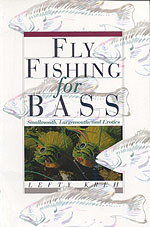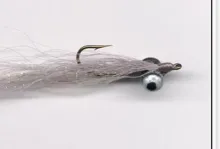Before we get to the review, I have to confess that I am a bit biased, as I've known Joe for a few years through his involvement in a fly tying email group of which we're both members. When he announced to the group that he published a book, I knew right away that I wanted to do a review. I was especially pleased when I learned the subject was warm water fly fishing, a subject which I have a keen interest in. When I lived "back home", I spent quite a bit of time chasing bass and pike in local streams and rivers. One of my favorite floats of all time is a stretch of the Mohawk River between Oriskany and Marcy, where the river slows flows through what can only be described as a northeastern jungle, and where you're never quite sure if the next fish that will hit will be a smallmouth bass, a walleye, or a northern pike. It's wild and wonderful.
Anyway - enough of that. Onto the book.
When I first heard that this was a self published book, I got a little nervous. I've seen a few other self published books by fly anglers, and they always seemed a bit like something printed off on their inkjet and spiral bound at their local Kinkos. Not so with Joe's book. If he didn't tell us it was self published, it would be impossible to guess. It's every bit as professionally presented as any book by one of the big publishing houses. Joe, a job well done!!
If there is one trait that "warm water" rivers and streams have in common, it is their biodiversity. They are just chock full of life of all forms, and Joe devotes an entire section of his book to the different prey species that can be encountered. While I'm sure it would be easy to overwhelm the reader with biology, Joe keeps the techno jargon to a minimum and instead gives us practical advice and helps us understand why knowing our forage is so important. Heck - the chapter on crayfish alone is worth the cover price.
One might think the section on game fish would include bass, maybe a panfish or two, and something toothy like a pike or a pickerel. Well - it does. But it also includes information about other target species such as carp and catfish. Even mooneye. What the heck is a mooneye? Joe knows. I had no idea.
I hope you're not getting the idea that "Fly Fishing Warn Water Rivers" is a dry technical book. Man, that's not even close to the truth. Yes, it has lots of facts. Yes, Joe passed along a ton of information to the reader. No, it does not read like a phone book. Check out this passage:
"The sky paled gray as clouds whipped overhead in the chilly 30-degree morning. The air was heavy with moisture and a gentle three to five mile per hour wind whispered out of the southeast and followed the river's course downstream. The mighty Ohio River flowed the color of hot chocolate while it flushed the remnants of the previous week's heavy rains toward the Mississippi, so many miles away.
"What's that?" Ron shouted as we neared the river's bank.
"Refrigerator" was my reply.
And so the appliance floated on its marry way, oblivious to our efforts to understand a fishing hole five feet below the water's present level.
There's nothing like a good fishing story.
I had a feeling Joe was a practical guy - most warmwater guys tend to be - and this was proven true in the section on tackle. His choice of a 6wt rod as the overall "general purpose" rod for this type of fishing reflect my choice exactly - heavy enough to cast most of the flies you'd use, light enough to let most of the fish show off a bit, and not so heavy as to be wear you out over the course of a day. I was also pleased to see that he didn't gloss over that most important piece of gear - the leader. I think we share the belief that a properly designed leader matched to your fly and the conditions will have more affect on your fishing enjoyment than the amount of money you spend on your rod or reel.
The book closes with sections on flies and tactics. Of course I was curious about Joe's fly selection, seeing as how I "met" him on a listserve devoted to streamers. Here again, Joe takes the practical approach and avoids the temptation to dump his fly boxes on the table and catalog each fly he's ever caught a fish on. He sticks to the favorites, and here again our interests intersect in his appreciation for classic flies. You won't find many books published after 2000 that mention the James Wood Bucktail or a Hornberg. I bet it killed Joe to prune down his list of patterns to this select few. I know it would be tough duty for me.
While it is true that I am a biased reviewer, I don't think I'm overstating anything when I say that Joe did himself proud with this book. "Fly Fishing Warm Water Rivers" is a book I can highly recommend with a crystal clear conscience. Get a copy. You won't be sorry.








